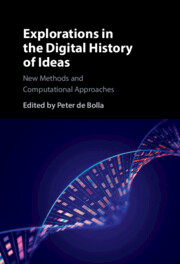Book contents
- Explorations in the Digital History of Ideas
- Explorations in the Digital History of Ideas
- Copyright page
- Contents
- Figures
- Tables
- Contributors
- Acknowledgements
- Part I Computational Methodologies for the History of Ideas
- Part II Case Studies in the Digital History of Ideas
- 4 The Idea of Liberty, 1600–1800
- 5 The Idea of Government in the British Eighteenth Century
- 6 Republicanism in the Founding of America
- 7 Enlightenment Entanglements of Improvement and Growth
- 8 The Idea of Commercial Society: Changing Contexts and Scales
- 9 The Age of Irritability
- 10 On Bubbles and Bubbling: The Idea of ‘The South Sea Bubble’
- 11 Embedded Ideas: Revolutionary Theory and Political Science in the Eighteenth Century
- 12 Computing Koselleck: Modelling Semantic Revolutions, 1720–1960
- Index
11 - Embedded Ideas: Revolutionary Theory and Political Science in the Eighteenth Century
from Part II - Case Studies in the Digital History of Ideas
Published online by Cambridge University Press: 09 November 2023
- Explorations in the Digital History of Ideas
- Explorations in the Digital History of Ideas
- Copyright page
- Contents
- Figures
- Tables
- Contributors
- Acknowledgements
- Part I Computational Methodologies for the History of Ideas
- Part II Case Studies in the Digital History of Ideas
- 4 The Idea of Liberty, 1600–1800
- 5 The Idea of Government in the British Eighteenth Century
- 6 Republicanism in the Founding of America
- 7 Enlightenment Entanglements of Improvement and Growth
- 8 The Idea of Commercial Society: Changing Contexts and Scales
- 9 The Age of Irritability
- 10 On Bubbles and Bubbling: The Idea of ‘The South Sea Bubble’
- 11 Embedded Ideas: Revolutionary Theory and Political Science in the Eighteenth Century
- 12 Computing Koselleck: Modelling Semantic Revolutions, 1720–1960
- Index
Summary
Using a new visualisation technique for word embedding data, this chapter explores the formation of complex, compound concepts in the late eighteenth century, focusing specifically on ‘political revolution’. Word embedding models offer an alternative method of understanding relationships between terms, both as a function of proximity (as in collocation) and of shared contexts (as in synonyms). By measuring the direct distance within the embedding space between two words over time in a series of aligned models, we can witness two parts of a compound idea bind together and observe which terms provide the binding force between them. Using this method, I explore the way that ‘revolution’ travels across the eighteenth century in relation to the ‘political’. Although loosely linked in the wake of the Glorious Revolution at the outset of the century, revolution becomes heavily tied to Newtonian mechanics, before being pulled back into political usage during the French Revolution. The method I introduce here reveals the hidden connections to ‘science’ in both political and revolution that undergirds their eventual merger into the idea of ‘political revolution’ that we have inherited today.
- Type
- Chapter
- Information
- Explorations in the Digital History of IdeasNew Methods and Computational Approaches, pp. 225 - 255Publisher: Cambridge University PressPrint publication year: 2023



